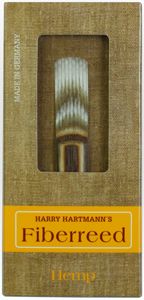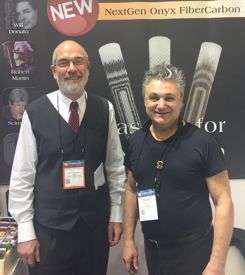Fiberreed Review
 I start the Fiberreed review video off by playing my long-time favorite cane reed which is the Vandoren Java. Thats the one in the green box. This Vandoren Java on a Guardala mouthpiece has been my setup for over 30 years and I’ve been very happy with it.
I start the Fiberreed review video off by playing my long-time favorite cane reed which is the Vandoren Java. Thats the one in the green box. This Vandoren Java on a Guardala mouthpiece has been my setup for over 30 years and I’ve been very happy with it.
For this Fiberreed review I played on a totally new saxophone tenor mouthpiece. This is the FiberCarbon Guardala MBII FatBoy. These FiberCarbon mouthpieces are a brand new product from Nadir Ibrahimoglu. Nadir, who is from Germany has been making authentic Dave Guardala metal mouthpieces for years now.
Nadir’s recent FiberCarbon saxophone mouthpiece lineup was just released in late 2016 I believe. I had a chance to try them recently at the 2017 NAMM show in Anaheim and was completely blown away by them. The one I chose was the tenor MBII Fatboy *8 model which is the one I’m playing in this video.
Meeting Fiberreeds creator, Harry Hartmann at the same NAMM show is the reason I was turned on to these reeds and so here we are!
So What Exactly is in this Video Fiberreed Review?
I play and talk a bit about the 3 established Fiberreed models which are:
- The Natural
- The Carbon
- The Hemp
We end with the newest member of the Fiberreed family:
4. The Carbon Onyx
1. The “Natural” Fiberreed
![]() The Natural is the very first model of this synthetic reed that was made by saxophonist and Fiberreed creator Harry Hartman.
The Natural is the very first model of this synthetic reed that was made by saxophonist and Fiberreed creator Harry Hartman.
While this Natural Fiberreed sounded fine it felt a little stiff to me so I didn’t feel I could get my full sound out of it. Still a very decent sounding reed but to seriously consider keeping it to play on any further I would need to sand it down a bit. That’s a good point regarding these reeds, even thought they’re synthetic you can still work on them with some fine sandpaper or the handy tool “Reed Geek”.
Personally, I don’t like to work too much on reeds. Like most people I like them to play perfectly right out of the box but with cane reeds these are just way too few and far between. This being one of the main reasons any of us are even looking at synthetic reeds.
This Natural Fiberreed didn’t feel as easy or comfortable to play as the Vandoren cane reed that I’m so used to. The sound wasn’t quite there either so let’s move on to the next one.
2. The “Carbon” Fiberreed
![]() Right at first sight the look of this reed is very different than the first one. The Natural is all white made from hollow fibers woven and layered together. This second reed, the Carbon has black carbon fibers layered in with the natural hollow fibers, giving it the darker black charcoal color.
Right at first sight the look of this reed is very different than the first one. The Natural is all white made from hollow fibers woven and layered together. This second reed, the Carbon has black carbon fibers layered in with the natural hollow fibers, giving it the darker black charcoal color.
Right away from the first few notes I could tell this is much more of my type of reed than the first one. It popped out quite a bit more with a clearer sound. It also felt a little easier to play, especially in the very low end but I still had to blow a bit too hard.
Again, a little work on this reed could possibly get it there. A little closer to the sound I look for and get from my cane reeds but not close enough.
3. The “Hemp” Fiberreed
![]() The Hemp reed has a more natural look to it probably because it’s made mostly from natural materials like hemp and a couple types of wood. So quite a few types of different materials compared to the first two reeds with a likely goal of getting even closer to the cane reed sound.
The Hemp reed has a more natural look to it probably because it’s made mostly from natural materials like hemp and a couple types of wood. So quite a few types of different materials compared to the first two reeds with a likely goal of getting even closer to the cane reed sound.
Upon blowing my first few notes I noticed immediately how easy it was to play. The easiest by far. The sound really projects with a bright tone that has that “buzz” I look for as well. Like the cane reed, it feels very consistent from the very low end up through the altissimo register.
4. The “Carbon Onyx” Fiberreed
![]() This is Harry Hartmann’s new and latest creation. The Carbon Onyx reed is different in it’s construction from his other 3. It isn’t made by weaving and layering different types of fibers together. It’s made entirely from the same material as the mouthpiece I’m using; the Fiber Carbon, which is a mixture of fiberglass and carbon.
This is Harry Hartmann’s new and latest creation. The Carbon Onyx reed is different in it’s construction from his other 3. It isn’t made by weaving and layering different types of fibers together. It’s made entirely from the same material as the mouthpiece I’m using; the Fiber Carbon, which is a mixture of fiberglass and carbon.
The brightness and buzz is less than the Hemp reed. The overall tone is fuller and warmer, especially on the low end. Very easy to play all around and even the low sub-tones were quite easy to get.
My Fiberreed Choice
I don’t know if all the nuances from each reed will be audible by everyone from this little video recording. I hope there was enough there for you to hear the main differences between all four reeds because there were pretty big differences for me. First in the way they all felt and the way they sounded.
The two Fiberreeds I will stay with are the Hemp and the Carbon Onyx.
These played the easiest and gave me the right amount of brightness, buzz and fullness that I’ve been getting from some of the highest quality cane reeds available.
Good Reed Advice From Dave Guardala
While I didn’t believe him at the time, I received some great advice from Dave Guardala. While I was ordering one of his mouthpieces he said that I should play the Vandoren Java’s on my Guardala Michael Brecker model mouthpiece. After all, that’s what Michael himself uses. I told him that I’ve tried vandorens before with previous mouthpieces and didn’t like them that much. This turned into a pretty funny argument about reeds but on the newly delivered mouthpiece was one of these Java reeds, compliments of Dave. Well, this setup has worked for the last 30 years so I’ve always been grateful for that!
The Cane Reed – A Love and Hate Relationship
This whole concept of a good-playing, nice-feeling synthetic reed sure is a good sounding idea for any of us who have spent many years playing only on a cane reed. My experience with the Vandorens, as great as they are, is that there’s only one really good one in a box of five. Sometimes two, and unless I want to really work on them that’s about it. That makes them very expensive and a constant hassle to keep a few good ones going.
Never mind the problems with warping, chipping and breaking towards their life’s end, which can come too quickly most of the time. I probably haven’t bought my last box of cane reeds but it’s a good feeling to know I can do just fine without them if need be. This is the first time I’ve ever been able to say that… thanks Harry Hartmann!




I don’t know what took you so long to get into synthetics. I’ve been playing synthetics for 30 years, starting with the Rico Plasticover (not a full synthetic I realize), then Fibercell, Fibercane, Bari, Legere and Hartmann’s. I’ve always played a cane for brief periods, but once you get a synthetic that you like, you’ll never go back to cane. It’s not that cane is bad (because they’re NOT), but just the hassle and come and gone of their life spans. I have a couple of synthetics that I’ve played for over a year or so. They’ve even have some handling damage . split, chipped tips, etc. and they STILL play great.
One of the problems I had with some synthetics is getting another one after a year or so of playing the old one. It seems that the consistency changes. I guess even synthetics eventually die.
For the past 2 years, I’ve been using Legere. I wasn’t impressed by the first one (the early plain model), but a friend advised their “Signature” model, and that was perfect – and still is after a year of using it.
I also tried the Hartmann reeds, mainly the carbon ones. OK, but not as good (for me) as the Legere.
However, I am going to try their latest. I also think that you did the best on that one too.
I also think that the sooner a student can get on one, the better. They’ll have the time to learn and play better, instead of the hour to hour to day hassle of cane.
I also feel that some synthetics are very mouthpiece friendly, especially good for guys like me that tend to collect (too) many mps.
Nice demo of those reeds.
Some great points Don. I think a total beginner can get pretty screwed up with a few bad reeds and not know the cause of the problem so having a sure thing in a good synthetic can be a great help.
I also tried plastic covered Rico’s a long time ago and liked them except they would split when screaming up high so I couldn’t use them.
I would agree that Legere can compare to the Natural Fiberreed but no where near their Hemp or the latest Carbon Onyx…at least not for me.
Hi; hope everybody is good. Oddly I was thinking about Hemp reeds only the other day. Thanks Johnny, look forward to giving them a blast on my new mpc. I sent off essentially a blank tenor mpc to a guy who has refaced for me in the past. No marking, other than it comes in at 110. I got it back only a coupla days back. He had thinned out the rails and altered the baffle….STOKED !! Have a great day…..jak
I just ordered the Medium Soft of the Onyx. I believe that this will work for me
Thank you very much Johnny
Vinny
Hi Johnny
I ordered two medium soft reeds, a Hemp, and a Carbon Onyx. I blow a vandoren java 2. According to the vandoren reed comparison index chart the Java 2 is like the traditional vandoren 1.5 so I might have to order a softer reed that more resembles the java 2.. I’ll let you know how it all works. I’m looking forward to carbon fiber mouthpieces. Cheers
William
Hey William, keep us posted cause that is very important information, which cane # strength works best with which synthetic strength. I first tried a medium hard and was turned off but with a medium the heavens opened up!
so, being off just one size could totally turn someone off and that would be a shame.
Based on your recommendation I’m going to try a Hemp to liven up the bland sounding Fatboy I recently got from Nadir. I haven’t tried Hartmann reeds in a very long time so I’m hoping (and betting) they are much improved. I used to use Fibracell and loved them until they got too buzzy for me. Did the reeds change, or did I? Maybe a little bit of both. Thanks for the reed update and all you do for the saxophone world. My grandson loves your site and I think it has really helped his progress.
I am using the Fiberreed Carbone on alto and tenor on a Fred Lebayle Jazz Metal MP since three years now and i love that sound! On baritone i use a Berg Larsen ebonite MP and the Fiberreeds doesn’t work on this setup. Using Forestone BlackBamboo ore Legere sound perfect to me.
Also good to know is that the synthetics are highly endurable. I had no problems so far!
Thanks you so much, Johnny for such a clear demonstration of these synthetic reeds. I have been using the original FiberReed and was thinking of ordering another one. I think I will try the Carbon Onyx and see how it works for me.
Ya Alice, I found the Onyx much more free-blowing than the original natural.
I’ve listened to the video 4 times and to be honest all 5 reeds sound good if you didn’t know the reeds were being changed, to me i’d put it down to either different saxophones being played or using some reeds not properly warmed up or that haven’t settled down.
The Java reed – to me sounds the best in terms of sounding closest to your natural voicing, which is what puts you apart from other players voicing. The high notes in particular sing more than the other 4 reeds. If you’ve ever played a recorder, then thats the sort of timbral sound that the 4 remind me of. What i’m trying to say is if everyone moved to synthetitic, then it’s going to be harder to distinguish between different players. Listen to an ewi and you’ll know what i am on about.
The ‘natural’ sounded very dark and has a lovely classical tone, the buzziness dies off very quickly.
The sound colour of the ‘carbon’ is a lot warmer than the ‘natural, slight increase of the time taken for the buzz to fade. But the notes still seem to die off rather quickly.
The ‘Hemp’ sounds more sensitive and sounds like it reacts more quickly to your embouchure changes, and the buzz doesn’t seem to die off as abruptly like the ‘natural’ and the ‘carbon’ reeds.
The loudness is probably down to it being more sensitive to dynamic changes. In other words the other two could be choking the volume.
The ‘Carbon’ reed, if you compare this to the java, you definitely sound like you’re not used to this reed, you sound like someone learning to pitch the notes.
It doesn’t sound as sensitive to your embouchure, and sounds more like the mouthpiece than your voicing. I don’t know if its a case of mouthpiece and reed being of similar material which is causing the mouthpiece to be less sensitive to the reed vibrational changes or not?
Out of the 4 synthetic reeds, to me the ‘Hemp’ sounded the best responsive one in terms sensitivity. The Java still sounds more sensitive and responds quicker to changes than the synthetic reeds.
In my case, being an inexperienced player ie someone who is not in full control of a sax compared to Johnny, the 1st, 2nd and 3rd synthetic reeds being less sensitive would make me sound a lot better than using the java and the hemp reed which i think would amplify my faults.
But this is only my oppinion – so please don’t take offence.
sorry i mean’t the 1st, 2nd and 4th synthetic reeds.
I found 12 medium soft fibracell tenor sax reeds yesterday stuck in the back of a drawer. I bought one soft and one medium soft fibracell reed in 1997 0r 1998. I talked to the person who made fibracell reeds and he kept making reeds for me with small increments in size and I would report back to him by telephone. No internet in those days where I was living. We had to walk through the woods going toward town. So I had a nice collection of fibracell reeds. I tried them all yesterday. Some blew like a Java 2.5, some like a Vandoren 2 (blue Box), some blew like a java 2 ( green box) with some buzz, and some blew like a java 3, and some blew like a 2×4. The new fiber hemp and Carbon Onyx reeds of 2017 will probably be an improvement over the fibracell models of 1998. . On thing about the synthetic reeds is that they will hold their own and not wear out..
wow that’s so cool William. would be very interested to see how they will compare. keep us posted.
Great demo Johnny on the onyx reed i`am looking fwd to play it when i receive it on my Weril Spectra A972wd3 it be different that already used legere synthetic and a lot of cane models .
HELP : I’VE USED 2.5 FIBERCELL REEDS FOR THE LAST 10 YEARS AND LOVED THEN 8 OUT 10 PLAYED PERFECT RIGHT OUT OF THE BOX. SO I RECENTLY ORDERD 10 MORE AND WAS VERY
DISAPPOINTED ,0 OUT 10 PLAYED HARD AND DULL SOUNDING. JUST WONDERING HAVE I;VE CHANGED OR THE REEDS. LOVE TO TRY THE CARBON ONYX REED BUT NOT SURE WHAT STRENGTH I SHOULD GO WITH. I HAVE ROUSSEAU C CLASSIC MOUTH PIECE AND A BG SAX LIGATURE.
when ordering an Onyx or a Copper choose #2.5 / Medium Soft
I’m going on personal experience because my Fibracell is a #3 and matches equally with my Onyx Medium and Copper #3 so you would be a 2.5 or medium soft.